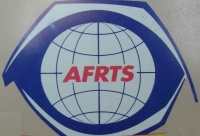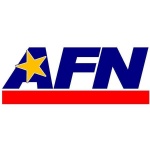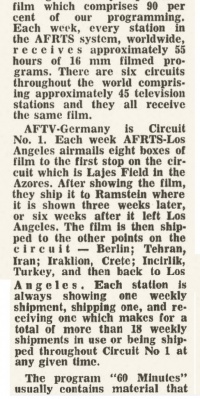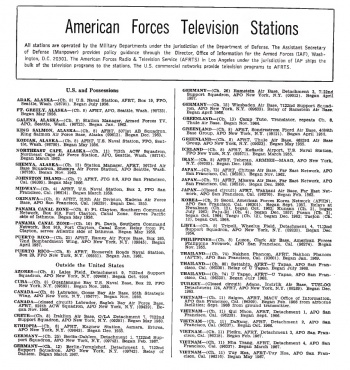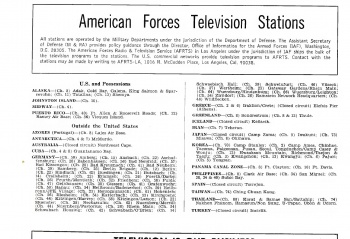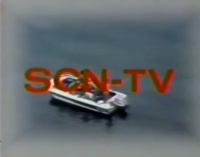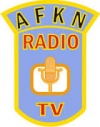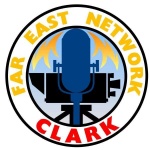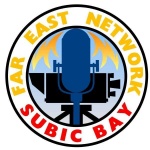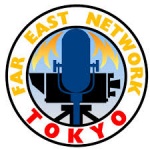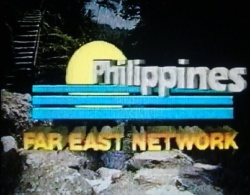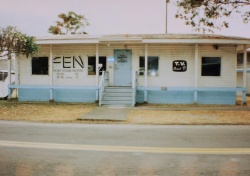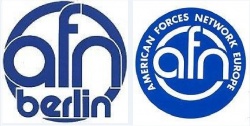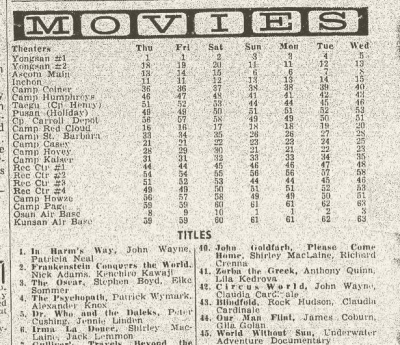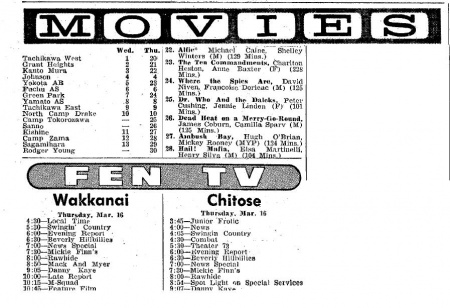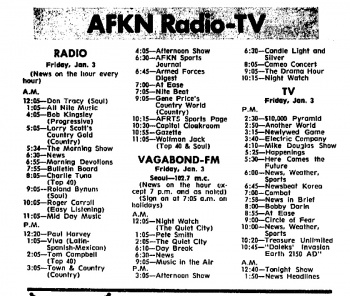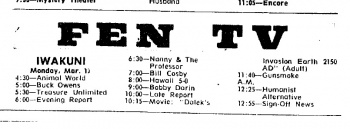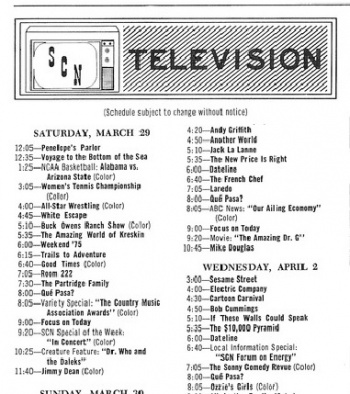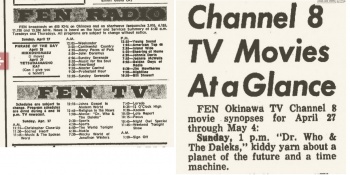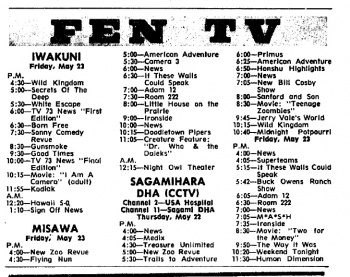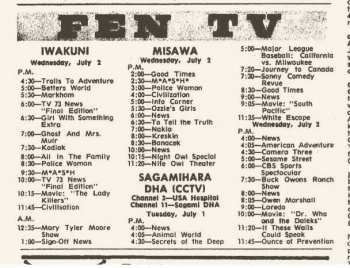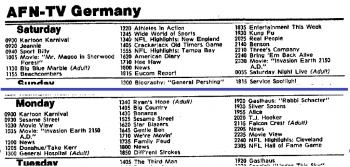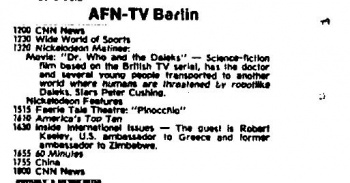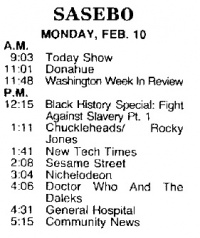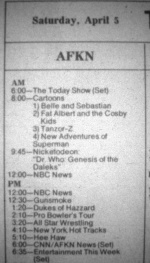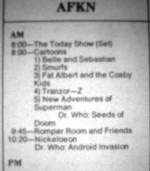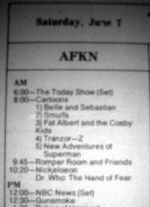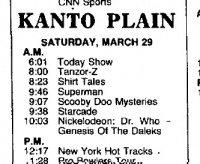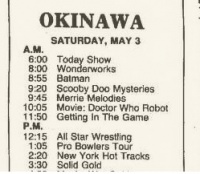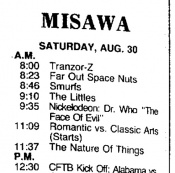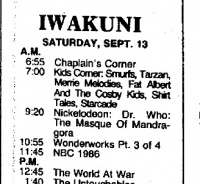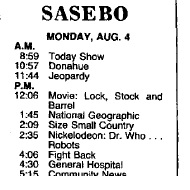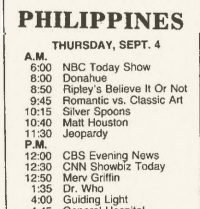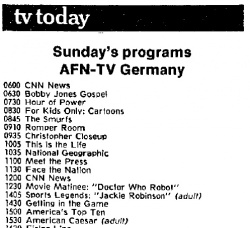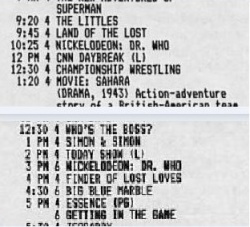Armed Forces Network
Profile
| Country Number (N/A) | 1986 | THIRD WAVE |
| Region | Asia; Europe; Middle East? | |
| Television commenced | 1955 (Networked) | |
| Colour System | Staggered from 1971 | NTSC |
Television Stations / Channels
The Armed Forces Radio Service (AFRS) was established in May 1942, primarily to provide radio broadcasts to American servicemen and their families abroad in countries where English is not a first language.
A very basic television service, Armed Forces Television (AFT) began broadcasting locally from the Limestone Air Force base in Maine from 25 December 1953.
The AFRS and AFT joined, to become the American Forces Radio and Television Services (AFRTS) in April 1954.
From early 1955, television stations began operating from US Air Force bases in Iceland; Bermuda; the Middle East (AJL-TV from the Dhahran base in Saudi Arabia, and AFTV in Tehran, Iran); in Germany; Central America and the Caribbean (such as Puerto Rico and Panama); and North Africa (the Wheelus Base in Tripoli, Libya).
In 1957, the first full radio and TV network was launched in Seoul, South Korea. The Far East Network commenced television broadcasts from the Philippines in 1954, and from Japan in 1960.
In 1966, as the network expanded, the AFRTS Programing Center (AFRTS-PC) was established in Los Angeles; the centre (renamed the Broadcast Centre in 1986) was responsible for selecting, processing, duplicating and distributing all programming for the networked stations.
Much of the entertainment content was provided to the AFRTS free of charge or very cheaply, with product supplied by the major US networks and distributors on a "goodwill" basis. However, in the event that a local TV station purchased a series that the AFRTS had been given for "free", the AFRTS was not able to screen it.
Although the AFRTS promoted that all programming was distributed without censorship, some "editing" of programs (NOTE: mainly radio) was necessary locally to:
- "remove specific words and phrases"
- "avoid injuring troop morale"
- "avoid helping the enemy"
- "prevent offending the sensitivities of the host nation"
This level of censorship – particularly with respect to host country sensitivities - was at the sole discretion of the base station commanders, but only with the permission of the AFRTS-PC.
Colour broadcasts in NTSC were introduced from 1971, although it took more than five years before all bases had been converted.
DISTRIBUTION
There were six circuits around the world through which tapes (for radio) and films were distributed (NOTE: the list below includes countries that were contained within each circuit but which may have joined or left the circuit at different times than the others in the circuit – see the different lists of AFRTS stations in 1970 and 1976 at right):
- Circuit 1: Germany, Libya (until 1970), Ethiopia (until 1973?), Iran (until 1979?), Saudi Arabia (until mid-1980s), Greece, Turkey, Spain
- Circuit 2: Alaska (joined Circuit 4 in late 1970s)
- Circuit 3: Canada (until 1973, when the station at Labrador was given to the CBC), Bermuda (in 1950s only), Greenland, Iceland (until 1970s)
- Circuit 4: Panama Canal Zone, Lajes Field in the Azores, Iceland, Cuba, Alaska (in the late 1970s), Puerto Rico
- Circuit 5 / 6: including Korea, Japan, Philippines, Johnson and Midway Atolls, Diego Garcia, Vietnam (until 1973), Thailand, Taiwan (until 1979). (Australia, New Zealand and McMurdo Station, Antarctica also later joined the Asia / Pacific circuits.)
After the films were sent around within each circuit, they were returned to Los Angeles for cleaning and checking (and replacing if need be) before being sent on to the next circuit.
All programmes on film (and later on video tape) were distributed in that same roughly west to east direction. With a large number of bases (there were as many as 45 in 1970, but only 21 in the mid-1970s – see lists at right), and each being supplied with the same film (i.e. there were no duplicates) it may have taken a reel over one year to be cycled through all the bases and all continents.
In mid-1977, the Circuits were altered when film kinescopes were phased out and replaced by video-tapes, which became the standard format until the late 1980s. In terms of the 1986 run of Doctor Who (see below), all episodes were distributed on videotape.
By the middle of 1985, with 88 radio stations and 35 land-based television outlets, plus over 1,000 broadcast facilities on American naval vessels, the AFRTS was the largest radio and television network in the world.
By the 1980s, advancements in satellite technology meant syndication packages of the same programming (mainly news and sports initially) could be delivered via the SATNET network to all bases at the same time. In due course, satellite replaced all physical formats such as film and video-tape for all programming, with AFRTS-PC in LA beaming everything directly to the US Bases around the world at the press of a button.
By the end of the 1980s, the networks were re-designated under the Armed Forces Network (AFN).
THE NETWORKS
Each region had a separate "network" of stations, operated by the army, the air force or the navy, across different countries. The networks relevant to this profile and broadcasts of Doctor Who were:
SOUTHERN COMMAND NETWORK (SCN) (PANAMA)
The Southern Command Network (SCN) was one of two AFRTS stations in Central America. Although it was part of the isthmus nation of Panama, the region known as the Panama Canal Zone was at the time a recognised territory of the United States.
Channel 8, based at army Fort Clayton, served the Pacific side of the isthmus, and was established in May 1956.
Channel 10, at Fort Davis, the army base in Albrook, served the Atlantic side, and also commenced operations in May 1956.
SCN discontinued broadcasting in 1999 prior to the turnover of the Canal Zone to the Republic of Panama.
AMERICAN FORCES KOREA NETWORK (AFKN)
Although it was also in the Far East, the Army-managed American Forces Korea Network (AFKN) in South Korea operated separately from the FEN, and as such had a much bigger budget.
Established in 1957, AFKN had more alternative programming because of strong competition from local South Korean TV stations which also sought to broadcast popular US shows.
By the mid-1960s, microwave and repeater transmitters enabled broadcasts by the AFKN to reach other parts of the country.
The AFKN broadcast out of Seoul on cable channel 2; Pusan (ch 2); Taegu (ch 12); Taejon (ch 12); Kwangju (ch 13) and Wonju (ch 2).
AFKN commenced colour broadcasts from 1977.
AFKN is now known as AFN-Korea.
FAR EAST NETWORK (FEN) (#1)
Established in the late 1950s, the Far East Network (FEN) was made up of Air Force Base radio stations in the Philippines, Japan, Guam, and on smaller islands in the Pacific Ocean.
In November 1954, Clarke Air Force base in the Philippines was the first overseas base under AFRTS to establish a regular television service.
The television service commenced in Japan on 24 December 1960.
In 1965, the Philippines stations split from the others to form their own network.
ARMED FORCES PHILIPPINES NETWORK (AFPN)
In 1965, the Philippines stations split from the FEN to form a new network, the AFPN.
Colour television broadcasts commenced in 1971.
In November 1974, the control of the AFPN Philippines radio and TV stations was combined with that of the AFTN, the Air Force's TV and radio network in Thailand and the US Navy's radio station in Taiwan, forming a new network equal in size to the FEN.
When the Thailand network closed down in May 1976, the AFPN once again became part of the Far East Network (FEN).
The Taiwan radio station became Armed Forces Network Radio Taiwan (AFNRT). On 16 April 1979, after it had been decommissioned when the US troops vacated the island, it became International Community Radio Taipei (ICRT).
(The contents of the radio station was left behind (despite Armed Forces regulations requiring that all material be destroyed) and placed into storage, including, it would seem, some episodes of Doctor Who... But see Taiwan Prints…))
FAR EAST NETWORK (FEN) (#2)
The AFPN was absorbed back into the Far East Network (FEN) in May 1976.
Although the "new" FEN operated as a full network, there were often regional differences and some programmes that aired in Japan did not air in the Philippines and vice versa. For instance, if a national Japanese television station was airing a series that FEN also had the rights to, FEN could not screen it, and so alternative programming was provided by AFRTS.
There were a number of stations in operation, serving different parts of the country, such as:
- Channel 17, a UHF channel that served the US Naval Station Subic Bay and the US Naval Air Station Cubi Point in Subic, Zambalas and Bataan Province. The area was ringed by mountains so the signal did not go very far. (As with many of the FEN channels, the "station" was often little more than a small hut – as this photo of the Channel 17 repeater station in Subic illustrates). The signal was also available to Barrio Barreto and Olongapo City, which also received transmissions by way of cable feed.
- Channel 14, served Clark Air Force base (see logo at top of the page), Wallace Air Station, and Camp O'Donnell in the Angeles City area. (Clarke AFB was the first of the AFRTS stations to launch a television service.)
- Channel 34, which served the Naval Communication Station San Miguel, the Naval Link Station Santa Rita.
- Channel 50, operated from Manila, and mainly served Administrative US Military and US Embassy staff working in the capital.
- An additional transmitter high up in the mountains reached Baguio City, and serviced the USAF base at Camp John Hay, while a fourth transmitter was in the capital, Manila, but that had been shut down in 1986 due to complaints from local TV stations over conflicting programme content. It went back on the air with a scrambled signal in 1989.
The FEN was disestablished in 1997 after 54 years of service and is now known as AFN-Japan.
AFTV GERMANY / AFTV BERLIN / AFN EUROPE
US Air Force bases across Europe, such as those in Berlin, Germany, Greece, and Greenland, did not introduce a television service until the late 1970s.
Limited US military television broadcasts were available in American Sector regions of West Germany in 1971, but it wasn't until much later that the service became a fully operational network.
AFTV Berlin, and AFTV Germany (covering the bases at Ramstein, Rhein-Main and Spangdahlem) were two of the American Forces Network – Europe stations.
NBS - ICELAND
Iceland introduced its own television service in 1966.
The US Naval Air Station at Keflavik was part of the AFRTS, and supplied with a weekly shipment of taped programming. It was a closed circuit system, and operated on Channel 4.
It was initially part of Circuit 3, which also included Greenland, but later joined Circuit 4, and received the bulk of its programming from Lajes Field in the Azores. In August 1977, it moved from fourth to third 'slot' in the circuit, instead receiving its programmes from Guantanamo Bay in Cuba. After screening, the films and tapes were sent to the Adak Army and Naval Base in Alaska.
In April 1977, the station was renamed the Naval / Navy Broadcasting Service (NBS). In April 1983, the TV station was connected to the AFRTS's direct satellite feed, and a second channel - Channel 6 - was launched.
The NATO Base was eventually vacated by the US in 2006.
DALEK MOVIES
PETER CUSHING Movies
As well as offering radio and television entertainment, many of the US military bases also had their own cinemas playing the latest movie offerings from the US and the UK.
The first of the two Dalek movies screened at several of the bases across Japan between October 1966 and March 1967 (such as at the Tokorozawa US military camp).
"Daleks Invasion Earth 2150 AD" and "Dr Who and the Daleks" (in that order) went into syndication on the various television stations around the globe, including Germany from January to April 1975, Panama in March 1975, and Japan (bicycled to the various bases, such as Iwakuni and Okinawa) from March 1975 until July 1975. For some of the screenings both films played as part of the regular late night "Creature Feature" series of horror or science fiction movies.
Both films also played over the CCTV system at the Sagamihara DHA hospital.
The sequel appeared again on the AFN-TV in Germany channels in January 1981 and from August to October 1983, and on the FEN stations in Japan during July and August 1983.
The first film also appeared on AFN Germany in 1985 (see below) and again on FEN in Japan in 1986:
Doctor Who on the AFRTS Networks
Although the majority of programming on AFN was American - sourced from the major commercial networks, such as ABC, CBS, FOX and NBC, as well as from PBS, CNN and other cable stations – the BBC's Doctor Who was supplied to the networks (presumably free of charge, which is why no "sale" of the series to AFRTS is recorded in any BBC documentation).
BBC Records
AFRTS is not named in any of the usual BBC Records. That is not altogether surprising, since the AFRTS acquired much of its programming for very little cost or for free; "free" sales would not be included in the same records as "paid" sales.
It's most likely that the series was marketed and distributed to AFRTS via Time-Life Films / Television and later Lionheart, who had the distribution rights throughout the US and its territories during the 1970s and 1980s, and therefore any "sales" to AFRTS could have been included under all other sales recorded as being to the "United States".
Stories Bought and Broadcast
This profile so far covers only the Tom Baker broadcasts.
TOM BAKER
22 stories, equivalent of 94 episodes in omnibus "movie" format:
| 4A | Robot | 4 |
| 4B | The Sontaran Experiment | 2 |
| 4E | Genesis of the Daleks | 6 |
| 4D | Revenge of the Cybermen | 4 |
| 4F | Terror of the Zygons | 4 |
| 4H | Planet of Evil | 4 |
| 4G | Pyramids of Mars | 4 |
| 4J | The Android Invasion | 4 |
| 4K | The Brain of Morbius | 4 |
| 4L | The Seeds of Doom | 6 |
| 4M | The Masque of Mandragora | 4 |
| 4N | The Hand of Fear | 4 |
| 4P | The Deadly Assassin | 4 |
| 4Q | The Face of Evil | 4 |
| 4R | The Robots of Death | 4 |
| 4S | The Talons of Weng-Chiang | 6 |
| 4V | Horror of Fang Rock | 4 |
| 4T | The Invisible Enemy | 4 |
| 4X | Image of the Fendahl | 4 |
| 4W | The Sun Makers | 4 |
| 4Y | Underworld | 4 |
| 4Z | The Invasion of Time | 6 |
For reasons that are not clear, The Ark in Space was not part of this package of episodes. Unlike many other broadcasters, the stories were aired in the correct story order.
The programme was supplied as NTSC colour video tapes in English, but most likely distributed to the networks via SATNET.
Transmission
TOM BAKER
The package of 22 "movies" aired during 1986 only.
One of the reasons why Doctor Who was dropped by the AFRTS after only one year may have been due to a self-imposed prohibition on non-US programming. The AFRTS provided programmes for American military personnel and their families, and as such British programmes like Doctor Who may have been perceived as unpopular (as was reported in a contemporary edition of Stars and Stripes which mentioned there had been complaints about non-US programming).
- NOTE: So far we have identified broadcasts of the Tom Baker stories on AFKN South Korea, the FEN stations in Japan, the Philippines, the station in Iceland (partially) and AFN-TV Germany only.
- It is highly probable that other AFN stations in other regions of the world also aired the same run of 94 episodes around the same time, but we have yet to locate listings for these.
- Stars and Stripes publishes "Pacific" and "Europe" editions, the only two editions available archived online. Other bases around the world would get the same basic newspaper but with the pages covering news that did not affect them replaced with pages featuring "local" news stories; TV listings pages would similarly be replaced with "local" listings.
- The Panama Canal Spillway, a newspaper issued in the Panama Canal Zone, published TV listings in the 1970s, but not in the 1980s.
- No issues prior to 1988 of Panama's Tropic Times have been sourced; although there are TV listings, the available issues are too late to have listings for Doctor Who.
- Some other bases also published their own in-house newspaper with the TV listings. These variations are not archived.
AFKN (KOREA)
In terms of the screenings covered by this profile, Korea was the second of the eight regions to air the Tom Baker series.
Doctor Who commenced on Saturday, 22 March 1986, and ended on 16 August 1986, at a timeslot of usually around 10.20am. Although the listing for Genesis of the Daleks is from 9.45am to 12.00, all subsequent 6-parters compilations are billed for the shorter time of 10.20am to 12.00.
FAR EAST NETWORK (FEN)
The FEN operated in Japan and the Philippines:
JAPAN (FEN)
As covered above, the second Peter Cushing Dalek movie, "Daleks Invasion Earth 2150 AD" aired on the FEN stations in January, March and April 1975, and again in July and August 1983.
The first of the two films, "Dr Who and the Daleks" aired in Sasebo on Monday, 10 February 1986 from 3.04 to 4.31pm. It's highly likely the film also aired on the other stations in Japan (it aired on AFN-TV in Germany in 1985 – see below) but we did not locate those billings.
The regular series Doctor Who was available on (at least) these five Japanese channels during 1986:
1) Kanto Plain (Channel 4)
In terms of the screenings covered by this profile, Kanto Plain was the first of the eight regions to air the fourth Doctor series.
Starting from Saturday, 15 March 1986 usually around 10.00am, the 22-week run ended on 9 August 1986.
Although the 19 July movie was billed as being The Invisible Enemy, it was probably Image of the Fendahl, which would have been the next story to air in sequence.
2) Okinawa (Channel 8)
In terms of the screenings covered by this profile, Okinawa was the fifth of the eight regions to air the series. (Okinawa was the site of the Kadena Airforce Base and a US Marine Corps facility.)
The programme ran from Saturday, 3 May 1986 until 27 September 1986, at various times prior to noon. One movie aired instead on Thursday, 19 June, presumably because they would be skipping an episode on 28 June. After that, the Saturday timeslot remained constant, usually around 12.20pm.
3) Misawa (Channel 25)
In terms of the screenings covered by this profile, Misawa Air Force base was the sixth of the eight regions to air the Baker episodes.
The series aired from Saturday, 31 May 1986 until 25 October 1986, usually at 9.35am.
4) Iwakuni (Channel 22)
In terms of the screenings covered by this profile, Iwakuni was the seventh of the eight regions to air the series. (A Marine Corps Air Service Station was based in Iwakuni.)
The run of movies played from Saturday, 5 July 1986 until 29 November 1986, usually starting at 9.20am.
5) Sasebo (Channel 23)
In terms of the screenings covered by this profile, Sasebo was the last of the eight regions to air the Tom Baker stories. (Sasebo was the location of a US Naval Station.)
The regular series commenced from Monday, 4 August 1986, screening usually around 2.00pm. The series then shifted to Saturdays, from 27 September until the final omnibus on 27 December 1986, usually playing at 10.25am.
- NOTE: The series may have been available on stations operating out of other military bases in Japan, but we have not identified any listings for those.
PHILIPPINES (FEN / FEN-P)
In terms of the screenings covered by this profile, the Philippines was the third of the eight regions to air the series.
Doctor Who was aired by the FEN Philippines channels, commencing on Thursday, 10 April 1986, and concluded on 4 September 1986, at various timeslots, but usually starting around 1.40pm or 2.30pm.
In June 1991 a number of FEN Philippines stations were forcibly shut down permanently due to the volcanic eruption of Mount Pinatubo.
EUROPE
GERMANY
In terms of the screenings covered by this profile, Germany was the fourth of the eight regions to air the Tom Baker serials.
As noted earlier, the first Peter Cushing Dalek movie, "Dr Who and the Daleks" aired as the AFN-TV Berlin "Nickelodeon Matinee" on Saturday, 9 November 1985 at 1.20pm, while the sequel, "Daleks Invasion Earth 2150 AD" aired in January 1981, and from August to October 1983, and again in July 1993.
The regular series commenced on Sunday, 13 April 1986, and concluded on 7 September 1986. All episodes aired from 12.30pm until 2pm, or by 3.00pm for the 6-parters.
Listings for AFN-TV Germany place the episodes under the banner of the "Movie Matinee" rather than "Nickelodeon" as was used by AFKN, AFTV Berlin and NBS Iceland.
ICELAND
Only one issue of the NATO Base Iceland military paper The White Falcon for 1986 -- with its 4-page pull-out TV insert the 'NBS TV Guide' intact -- was available online, and this had listings covering 7-13 June.
On Saturday, 7 June 1986 at 10.25am to 12pm on Channel 4, and on Thursday, 12 June 1986, at 3.00 to 4.30pm on Channel 6 were listings for "NICKELODEON: DR. WHO". It is not possible to determine what stories these were, but based on both having 90 minute timeslots, they would be 4-parters.
It is unknown whether the 'two stories per week' was regular or infrequent scheduling. Of note, the Okinawa station in Japan also showed an 'extra' story during mid-June: the regular Saturday screenings on 14 and 21 June and a one-off serial on Thursday 19 June. It would appear that Okinawa and Iceland were the only AFRTS stations (that we have airdates for) to screen the series in that manner.
In Okinawa's case, it skipped an episode on 28 June, so the addition of 19 June to their schedules was likely to make up for missing that subsequent week; chances are Iceland also skipped a Saturday during the run and the 'extra' Thursday screening on 12 June made up for this, but without further confirmed NBS airdates we cannot be absolutely certain.
The use of the 'name' "Nickelodeon" is consistent with other AFRTS stations, since the series was being shown as a series of "movies".
TV listings
| ← AIRDATES ...... (CLICK ICON TO GO TO TABLE SHOWING EPISODE BREAKDOWN AND AIRDATES - N/S = story title is Not Stated) |
The Tom Baker listings have come from the European and Pacific editions of the US Military newspaper Stars and Stripes, accessed online at
Stars and Stripes Archive. (NOTE: the archive is not free to view, but offers relatively cheap short term options.)
For the screenings in Korea, listings were also sourced and verified from the Korea Times.
The online archive Berlin Observer provided listings for AFN-TV in Germany.
The two listings for the Iceland screenings come from an online edition of the US military paper The White Falcon here.
Story titles were given for the majority of cases, although from September 1986, just "Nickelodeon" was used for the Japan listings.
NOTE: The TV listings often gave the billings for the series as "Nickelodeon: Dr Who" or sometimes just "Nickelodeon". We think use of that name is merely a generic "Movie for Children" descriptor rather than an indication that the programme is from the much later-established Nickelodeon franchise of international channels, such as Nickelodeon (Japan) and Nickelodeon (Korea).
On 24 May and 31 May 1986, a printing error in the Korean Times places both The Android Invasion and The Seeds of Doom in the same listing.
For some regions, for The Invasion of Time part six, the listing simply said "(End)".
